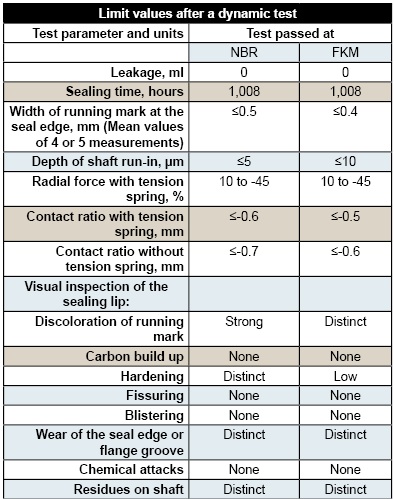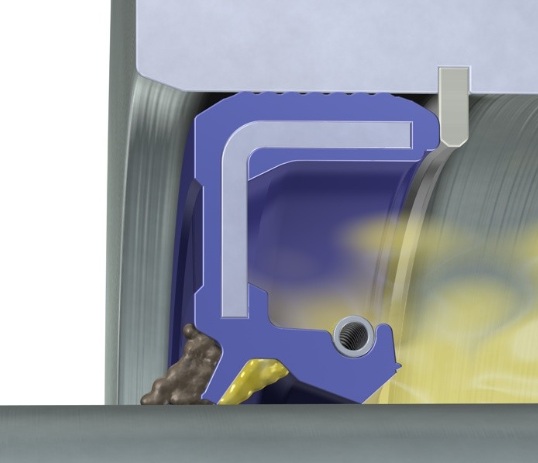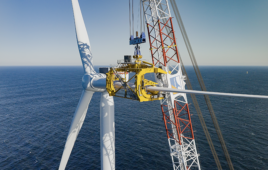An ideal combination of radial shaft seal, shaft surface, and lubricant can increase seal life three-fold and reduce friction at the sealing lip by up to 30%.

The test machine measures friction levels for a combination of seal material, shaft surface, and lubricant.
Nacelles become oily places when wind seals don’t work well. To find better seals, our companies developed a way to work in close cooperation with users to design tailor-made solutions that improve gearbox performance and life-seal predictions. Here’s what we learned.
A little background
Radial shaft seals are used in industrial gearboxes to prevent leakage and keep out contamination. The gearbox lubricant is usually selected according to the requirements of the gears and bearings, and not necessarily the seals. An equally important criterion for selecting the right radial shaft seal considers the influence of the lubricant on the wind turbine seal material along with load, speed, temperature, and life.
Gear oils are classified according to DIN standard 51 517/03 and, therefore, comply with considerable protection requirements against fretting and rolling bearing wear. Elastomer compatibility under static conditions is another consideration. However, practical experience has shown this is not enough to fulfill the multiple industry requirements regarding seal reliability and life under assumed operational conditions.
Industrial gear oils
These normally consist of a mineral or synthetic-base oil. The base oil is 85 to 98% of the lubricant, complemented by additives. In Germany, 70 to 80% of gears are lubricated with mineral oil, while the remaining 20 to 30% use synthetic gear oils. Most wind-turbine gearboxes are filled with a synthetic lubricant.
Mineral oils have been the traditional basis for gear oils for decades. Additives normally dissolve well in these base oils. Elastomer (seal) compatibility is predominantly influenced by the additives selected.
Polyalphaolefins (PAO) are the most commonly used base oils for synthetic gear oils. They show better viscosity-temperature behavior, good low-temperature characteristics, and help reduce friction. Unlike mineral oils, elastomer compatibility with polyalphaolefin oils is influenced by the combination of base oils and additives.
Polyglycols (PAG) are another important group of synthetic gear oils. They have the same benefits of polyalphaolefins and like mineral oils, elastomer compatibility comes from the additives.
Synthetic esters offer the same advantages as polyglycols and polyalphaolefins. However, unlike mineral oils, elastomer compatibility is influenced by the different ester oil types and the additives.
Shaft seal materials
Seals are usually made of rubber-like materials called elastomers. These long-chain molecules combine with additives to provide specific and technical material properties. Sealing materials based on butadiene-acrylonitrile and fluorinated rubbers are, with few exceptions, the proven and preferred wind turbine sealing materials used in industrial-gear applications.
Butadiene-acrylonitrile rubber (NBR) shows good swelling resistance in hydrocarbons along with high resistance to hot water, and inorganic acids and bases. However, when exposed to benzene, chlorinated hydrocarbons, esters, polar solvents, and polyglycol-ether brake liquids, considerable swelling occurs.
Fluorinated rubber (FKM) shows high temperature resistance, high chemical stability and good swelling resistance in hydrocarbons. Like NBR materials, FKM materials also tend to swell considerably when exposed to polar solvents and flame-resistant hydraulic fluids.
 Interactions in the tribological system
Interactions in the tribological system
The function of a radial shaft seal primarily depends on its geometry and the elastomer material. Radial shaft seals work like a small pump transporting liquids, gases, and dirt particles around it through the sealing edge. This effect is also used to pump small leaked amounts back into the sealed area. This intentional unmeasurable leakage is required for reliable lubrication and function of the radial shaft seal. It also has a considerable influence on its service life.
Leak-free sealing of the rotating shaft is ensured by the pressure of the sealing lip on the shaft. This force generates an asymmetric pressure distribution on the shaft dependent on the design of the seal-lip angle and tension-spring space. The pressure together with the elastic material properties cause the pump effect.
Considerable heat generates under the shaft seal’s sealing edge due to friction generated by the pressing force, the rotating speed of the shaft, and other factors,
Permanent interaction between the sealing material and lubricant is due to strong shearing forces combined with atmospheric oxygen. Therefore, it is critical to optimize the combination of shaft seal, lubricant, and shaft surface finish to ensure trouble-free operation.
Elastomer compatibility
The chemical and physical resistance of the sealing material to the proposed lubricant must be considered along with the sealing material and operational temperature range. The behavior of rubber-like materials toward liquids is tested to DIN ISO 1817 in the specific medium or standard test liquids.
To determine static elastomer compatibility, S2 standard-test pieces and discs are punched from a 2-mm thick test sheet and stored in the test medium. For better correspondence between static and dynamic test results and practical conditions, Freudenberg increased the test duration for mineral oils from 168 to 1,008 h. After immersion in the test medium, test pieces are inspected with regard to changes in hardness, tensile strength, and ultimate elongation according to DIN 53504. Volume changes are determined according to DIN ISO 1817. Standard static compatibility tests were traditionally used for lubricant approvals, but it is now more representative to conduct dynamic seal testing as well. Dynamic oil compatibility tests following DIN 3761 and reducing friction deserve further discussion.

The illustration provides a closer look at the pump action or area of the seal. The tan arrows indicate lubricant circulation.
Flender AG developed the testing program. Dynamic seal testing is undertaken on DIN-standard test benches. The radial shaft seals are analyzed by measuring relevant functional parameters and by visual inspection. For approval, the variation compared to the original measurements is decisive. Visual inspection results are based on experimental values.
The friction between seal and shaft is an important indicator of the expected wind turbine seal life. It should be kept as low as possible because the friction heat generated by the sealing system influences gear efficiency and lubricant temperature. Temperature increases of only 10°C reduce the life of the radial shaft seal and gear oil by half.
The cooperative project, called Lube&Seal, focuses on determining the frictional moment, or power loss, for all wind seal and lubricant combinations as a function of speed, temperature, lubricant additives, and viscosity.
Initial findings on lubricant additives prove that different additives in the same base oil considerably influence the frictional moment and temperature in the shaft seal’s sealing zone. The example shows that the frictional moment and temperature are considerably higher with the lubricant polyglycol (PAG) 1 than with PAG 2 over the entire speed range, regardless of the oil sump temperature.

The cross section shows a typical elastomeric radial-shaft seal at work. The spring (circular detail) pulls it tight against the shaft.
Energy and CO2 emission reduction
Basic research projects have shown that the right combination of radial shaft seal (material and shape) and lubricant can considerably reduce friction. A few rough calculations deliver the following figures, assuming a typical industrial gearbox with three seals and running for 5,000 hrs p.a. Then the power loss using:
-Standard radial shaft seals is about 90 W
-Optimized standard radial shaft seals is about 60 W
The potential energy-saving for an entire installation means a remarkable potential reduction of CO2 emissions. A gear manufacturer making one million gearboxes per year could reduce industrial CO2 emissions by about 25 tons simply through changing oil and seals (1 kW corresponds to average carbon dioxide emissions of about 500 g).
Industry requirements regarding tightness and reliability of radial shaft seals are ever-increasing. Elastomer compatibility of a lubricant, besides speed and temperature, is of particular importance to meet these increased requirements. Experience shows that testing only static elastomer compatibility is insufficient. Dynamic seal testing is indispensable because only these tests allow reliable conclusions on the long-term behavior of the shaft and seal tribosystem under lubricant exposure.
With an ideal combination of radial shaft seal, shaft, and lubricant, wind turbine seal life can increase three-fold and friction at the sealing lip can be reduced by up to 30%. As a consequence of this work, it’s also possible to considerably reduce CO2 emissions. However, the complex interaction between lubricant and sealing material must be thoroughly investigated to realize these reductions. WPE
By:
Erich Prem, Product Development Engineer Leadcenter Simmeringe, Freudenberg Simmerringe, www.Freudenberg-ds.com
Hermann Seibert, Head of Application Engineering, Klüber Lubrication Munchen KG, www.kluber.com
Filed Under: Components, Seals & slip rings






ISO 1817 lubricant
i need quote for this
Please reach out to the company directly.